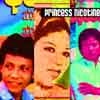 Bizarre radio collages might be the most spectacular examples of AlanBishop's peculiar style of ethnomusicology, but the fewmore-traditional "song" collections available from the Sun City Girl'sSublime Frequencies label provide equally fascinating glimpses intocultures that, while previously documented, have surely never receivedthe kind of treatment Bishop thankfully feels compelled to provide. Thesame guerilla tactics that spawned the string of Radio releases are responsible for Princess Nicotine and its predecessor, Folk and Pop Sounds of Sumatra Vol.1,both discs gathered from tapes Bishop collected over two decades oftraveling through Indonesia and Southeast Asia. In compiling hissouvenirs for release, the label owner flaunts the idiosyncratic and(to a degree) more intimate character of his collections, which, at thevery least, offer a refreshing break from over-ambitious, survey-styledcomps. Bishop's a-scholastic method also serves as introduction tomusic previously avoided by dominant, purist-oriented "world music"markets. "Folk and Pop" become blanket terms to describe an explosionof hybrid styles, mesmerizing mash-ups of traditional Burmese songforms with a range of disparate Western influences often more at oddswith each other than with their Eastern counterparts. Bishop seemsintent on granting these largely undocumented currents, "polluted" bymost ethnomusicologists' standards, the relevance they deserve, and ongrounds of this first volume alone, he has succeeded. Princesswas actually released in a shortened and very limited version back in1994, and it's no wonder the curator has decided to bring it back. Eachof the twelve tracks is an entirely distinct piece of what could becomemy favorite discovery of the year. The Burmese integrate elements ofWestern pop, psych, jazz, even fragments of generic theatre and filmmusic in such unique and self-serving ways that any referentialmaterial becomes blank fodder for compositions singular in both theiremotional immediacy and hallucinogenic grandeur. When it's at allenergetic, the music is utterly wild, with discordant scales collidingon frantic solo flights and cymbal bursts punctuating each intricateturn and jump of the vocalists, often engaged in the intenselystructured call-and-response to which much of the music hinges withmiraculous precision. The calmer tracks are no less astounding;propelled by reeds, violin, chirping flutes, and the incomparable,entirely characteristic Burmese approach to the piano, they are allstrangely psychedelic, breezy but charged with a jazzist edge andenough abrupt shifts and tangential melodic parts to fit with Westernprog definitions. One song sounds like a warped version of antiqueDisney film music; another takes what could be the saccharine,string-laden climax to an off-Broadway ham hit and, through theaddition of only a few thin piano lines and other percussive scatter,creates a string of delicate, truly moving passages. Bishop does notlie when he talks about the "very distinct" nature of this music,something that is unfortunately hard to communicate without relying onWestern points of reference. I will say that previous exposure toseveral of the scant Burmese collections available domestically (evento the Sun City Girls' more adventurous ethnic borrowing) has in no wayprepared me for the treasures of Princess, and, given Sublime Frequencies' rapid release schedule, a second volume should not be far behind.
Bizarre radio collages might be the most spectacular examples of AlanBishop's peculiar style of ethnomusicology, but the fewmore-traditional "song" collections available from the Sun City Girl'sSublime Frequencies label provide equally fascinating glimpses intocultures that, while previously documented, have surely never receivedthe kind of treatment Bishop thankfully feels compelled to provide. Thesame guerilla tactics that spawned the string of Radio releases are responsible for Princess Nicotine and its predecessor, Folk and Pop Sounds of Sumatra Vol.1,both discs gathered from tapes Bishop collected over two decades oftraveling through Indonesia and Southeast Asia. In compiling hissouvenirs for release, the label owner flaunts the idiosyncratic and(to a degree) more intimate character of his collections, which, at thevery least, offer a refreshing break from over-ambitious, survey-styledcomps. Bishop's a-scholastic method also serves as introduction tomusic previously avoided by dominant, purist-oriented "world music"markets. "Folk and Pop" become blanket terms to describe an explosionof hybrid styles, mesmerizing mash-ups of traditional Burmese songforms with a range of disparate Western influences often more at oddswith each other than with their Eastern counterparts. Bishop seemsintent on granting these largely undocumented currents, "polluted" bymost ethnomusicologists' standards, the relevance they deserve, and ongrounds of this first volume alone, he has succeeded. Princesswas actually released in a shortened and very limited version back in1994, and it's no wonder the curator has decided to bring it back. Eachof the twelve tracks is an entirely distinct piece of what could becomemy favorite discovery of the year. The Burmese integrate elements ofWestern pop, psych, jazz, even fragments of generic theatre and filmmusic in such unique and self-serving ways that any referentialmaterial becomes blank fodder for compositions singular in both theiremotional immediacy and hallucinogenic grandeur. When it's at allenergetic, the music is utterly wild, with discordant scales collidingon frantic solo flights and cymbal bursts punctuating each intricateturn and jump of the vocalists, often engaged in the intenselystructured call-and-response to which much of the music hinges withmiraculous precision. The calmer tracks are no less astounding;propelled by reeds, violin, chirping flutes, and the incomparable,entirely characteristic Burmese approach to the piano, they are allstrangely psychedelic, breezy but charged with a jazzist edge andenough abrupt shifts and tangential melodic parts to fit with Westernprog definitions. One song sounds like a warped version of antiqueDisney film music; another takes what could be the saccharine,string-laden climax to an off-Broadway ham hit and, through theaddition of only a few thin piano lines and other percussive scatter,creates a string of delicate, truly moving passages. Bishop does notlie when he talks about the "very distinct" nature of this music,something that is unfortunately hard to communicate without relying onWestern points of reference. I will say that previous exposure toseveral of the scant Burmese collections available domestically (evento the Sun City Girls' more adventurous ethnic borrowing) has in no wayprepared me for the treasures of Princess, and, given Sublime Frequencies' rapid release schedule, a second volume should not be far behind.- Bo HeinBurmese Golden Drum
- Mar Mar AyeBeautiful Town
- Tonte TheintanLover of the Winter and Snow
Read More

